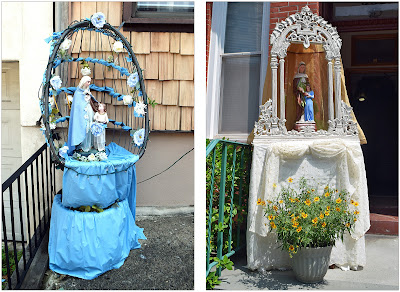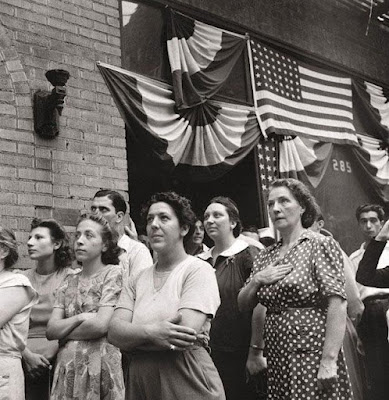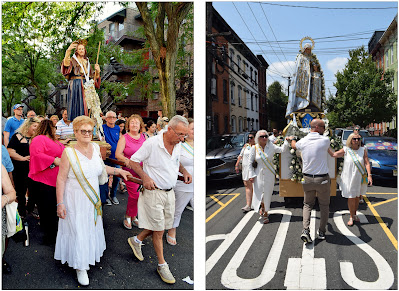 |
| Photo by New York Scugnizzo |
July 29, 2023
A Look at the 113th Annual Feast of Saint Ann in Hoboken, New Jersey (Part 2: Churches & Chapel)
 |
| Sant'Anna, ora pro nobis |
 |
| The ornate high altar inside Saint Ann's Church |
 |
| Statues of the Madonna Dei Martiri and San Rocco di Montpellier |
 |
| (L-R) Stained glass windows of Santa Elisabetta, San Ludovico XIV, Santa Teresa di Lisieux, and San Gennaro |
 |
| (L) Shrine to Sant'Anna. (R) Statue of Santa Rita |
 |
| Statues of San Giovanni Battista and San Rocco |
 |
| (L) Statue of the Madonna Dei Martiri. (R) Stained glass window of San Giovanni Battista |
 |
| Stained glass windows of San Giorgio and Santa Caterina d'Alessandria |
 |
| (L) Detail of the ceiling depicting San Francesco d'Assisi's vision of the Crucified Christ. (R) Madonna della Libera, patroness of Rodi Garganico in Foggia |
July 28, 2023
A Look at the 113th Annual Feast of Saint Ann in Hoboken, New Jersey (Part 1: The Procession)
 |
| After Mass, the Holy Name Society carried St. Ann out of the church |
 |
| Father Remo Di Salvatore and His Excellency the Most Reverend Arthur Joseph Serratelli enjoying the festivities |
 |
| Departing St. Ann's Church, the procession makes its way through the fairgrounds |
 |
| Members of the St. Ann's Guild |
 |
| Members of the Italian Apostolate of the Archdiocese of Newark, NJ |
 |
| Our friends from the Madonna della Neve Society of Brooklyn, NY (& Steve) |
 |
| Our buddy Jude with his mom and son |
 |
| (Above & below) The procession wends its way through Hoboken |
 |
| We stopped by Lisa's Italian Deli for cold water and watermelon |
 |
| We enjoyed some delicious focaccia at the Madonna Dei Martiri clubhouse |
 |
| Devotees erected shrines to St. Ann outside their homes and businesses |
 |
| (L) Statue of Sant'Anna outside Failla Memorial Home. (R) Donations are pinned on to the statue of San Giacomo |
 |
| San Giacomo greets Sant'Anna outside the Monte San Giacomo clubhouse |
 |
| We were treated to delicious roast beef and hot pepper sandwiches |
 |
| San Giacomo joins the procession |
 |
| (L) The Company Kafe generously offer participants watermelon. (R) Msgr. Paul Bochicchio blesses the participants outside St. Francis Church |
 |
| The roisterous John Duke Band |
 |
| After the procession, St. Ann is carried back into the church |
 |
| San Giacomo and Sant'Anna are returned to the church sanctuary |
 |
| Fr. Remo blessed us with the relic of Sant'Anna |
 |
| Returning to the fairgrounds, we met up with some good friends and enjoyed some of Lou's homemade wine |
July 27, 2023
Among the Ruins and the Forest Passage
 |
| Roman Theater in Taormina by Louise-Joséphine Sarazin de Belmont currently on view at the Morgan Library and Museum |
"It shows a healthy instinct that today’s youth is beginning to show new interest in religion. Even if the churches should prove themselves unable to cater to this instinct, the initiative is important because it creates a framework for comparisons. It reveals what was possible in the past, and hence what one may be justified in expecting from the future. What was possible is still recognizable today in only a single limited field, that of art history. Yet the futurists were at least right about one thing: that all the paintings, palaces, and museum cities mean nothing in comparison with the primal creative force. The mighty current that left all these creations in its wake like colorful seashells can never run dry—it continues to flow deep underground. If man looks into himself, he will rediscover it. And with that he will create points in the desert where oases become possible." ~ Ernst Jünger, The Forest Passage, Telos, 2013, p.64
Navigating the ruins of modernity we sometimes catch glimpses of perennial beauty amidst the decadence and squalor. In New York City, an effort must sometimes be made to reach these rapidly disappearing oases, but the reward is often edifying and invigorating. In fact, the experiences are usually heightened by the clashing and antithetical tumult surrounding them.
 |
| Sign promoting the Into the Woods exhibition outside the Museum |
Located in the lower level gallery is Sketching Among the Ruins, a small collection of oil paintings by various landscape artists jointly given to the Morgan Library and Museum and the Metropolitan Museum of Art in 2009 by Eugene V. Thaw, a trustee of both institutions.
Focusing mainly on studies of the Roman Campagna and its many ruins, the highlight of the collection is clearly The Roman Theater in Taormina, Sicily (1825), by Louise-Joséphine Sarazin de Belmont (1790-1870). Oil on paper and mounted on board, the painting was executed during her travels through the Papal States and the Kingdom of the Two Sicilies between 1824 to 1826.
Interestingly, she made a similar painting in 1828 with a more active Mount Etna and two Capuchin monks giving alms to a beggar. This version can be found in the National Gallery of Art in Washington D.C.
 |
| Roman Theater in Taormina by Louise-Joséphine Sarazin de Belmont at the National Gallery of Art in Washington D.C. |
Opposite the landscape sketches in a glass showcase on the wall is A Focus on the Figure: Selections from the Karen B. Cohen Gift. This assemblage of figurative drawings celebrates the 139 works (42 drawings, 95 photographs and two letters) generously given to the Morgan Library and Museum by Karen B. Cohen.
Among the works presented here is a chalk drawing of the Death of Alcestis (ca. 1814) by the renowned French painter Pierre-Narcisse Guérin (1774–1833). A hauntingly beautiful piece, it masterfully depicts the (once-)popular myth of the tragic death of Queen Alcestis, who willingly sacrificed her life in exchange for her husband’s (King Admetus of Thessaly). In the ancient Hellenic world, she came to personify the feminine virtues of selflessness, loyalty and devotion.
 |
| Portrait of Mrs. J.P. Morgan, Jr. by John Singer Sargent |
On the second floor, in the Engelhard Gallery, we viewed Into the Woods: French Drawings and Photographs from the Karen B. Cohen Gift, a selection of over fifty works on paper depicting rural landscapes and their inhabitants.
Losing ourselves in the woods, metaphorically speaking, we circled the gallery several times, returning to the most interesting pieces and marveling at the evocative beauty of a bygone age. My favorites were Moonlit Landscape (1862) by Jean-Baptiste-Camille Corot (1796-1875), Study for Forest of Fontainebleau: Hunters (ca. 1866) by Paul Huet (1803-1869), and Fisherwoman Holding Nets (ca. 1865-75) by Jules Breton (18227-1906).
 |
| Fisherwoman Holding Nets by Jules Breton, p. 11 of the exhibit brochure |
No visit would be complete without seeing the interior of J. Pierpont Morgan’s stately library and study. Filled with priceless literary works, musical manuscripts, and works of art, the jewels of the collection are the illuminated manuscripts, among which are the Crusader Bible (1240s), Farnese Hours (1546), and Glazier Codex, a 5th century Coptic manuscript containing the first half of the Acts of the Apostles.
Though currently not on view, the library’s collection of Medieval and Renaissance manuscripts and letters from Naples will certainly be of interest to many of our readers. In a cursory search online I found: Fasciculus temporum (ca. 1498); In laudem neapolitane civitatis (ca. 1480); Psalter, prayerbook of Ferdinand I of Aragon (late 15th century); and De sphaera Mundi (last quarter of the 15th century); among many others.
Also in the archives can be found drawings from a veritable who’s who of celebrated artists from the Kingdom of Naples, such as Francesco Solimena, Luca Giordano, Mattia Preti, Francesco de Mura, Andrea Vaccaro, Aniello Falcone, Paolo De Matteis, Salvator Rosa, Massimo Stanzioni, Gian Lorenzo Bernini, and Giacinto Gigante.
 |
| J.P. Morgan's Library (photo from previous visit) |
 |
| Running Eros with Torch (photo from previous visit) |
Another quick search and I discovered that the Fascículos temporum was acquired at the Aldenham Library sale in London, at Sotheby’s on March 1937; In laudem neapolitane civitatis with the Aragonese library was brought to Spain in 1550 by Ferdinand of Aragon, Duke of Calabria; and the De sphaera Mundi was purchased in July 1910 from Alexandre Imbert (1865-1943), a French antiquarian (born in Naples and based in Rome) who devoted most of his time between 1907-1912 helping J.P. Morgan build his prodigious collection.
I’m not sure if any of these items were once part of the State Archives of Naples, but even if one historical document or drawing was rescued from that spiteful act of barbarity it was a blessing.
 |
| Sign promoting the Ferdinand Hodler exhibition outside the museum |
Maybe it’s just me, but considering J.P. Morgan never collected modern art and there is an enormous amount of unseen treasures kept in storage, I would like to see more of the great bibliophile’s wondrous collection put on display. After all, there is no shortage of museums and galleries in the city to see modern art—heck, just look at every defaced building. This is not to say they shouldn’t have any visiting exhibits, after all, I absolutely loved the Tolkien: Maker of Middle Earth exhibit back in 2019, I just think the installations should just better reflect J.P. Morgan’s grand vision.
 |
| Before leaving I grabbed a free Into the Woods brochure as a keepsake and bought a handful of postcards from the gift shop for my collection |
Worth scheduling a visit, Into the Woods: French Drawings and Photographs from the Karen B. Cohen Gift runs till October 22, 2023, and Sketching among the Ruins runs till November 12, 2023.
~ Giovanni di Napoli, July 26th, Feast of Sant'Anna
Upcoming exhibitions:
• Seeds of Knowledge: Early Modern Illustrated Herbals — October 6, 2023 through January 14, 2024
• Morgan's Bibles: Splendor in Scripture — October 20, 2023 through January 21, 2024
• Spirit and Invention: Drawings by Giambattista and Domenico Tiepolo — October 27, 2023 through January 28, 2024
• Medieval Money, Merchants, and Morality — November 10, 2023 through March 10, 2024
July 23, 2023
“Doing Diaspora” Well
 |
| Italian Americans watching a flag raising ceremony at the Feast of San Rocco in NYC, photo ca. 1942, by Marjory Collins (1912-1985) |
Submitted by Erasmo Russo
It has been jokingly said that the average Italian maintains that his fellow Italian is not authentically Italian unless he too has suffered to the same degree at the hands of the state with its poor governance and malfeasance as he himself has suffered. There is some truth in this linkage of shared suffering as an eternal bond, sufficient enough to unite the ethnos or nation, or indeed to create the nation. Those of us old enough to have lived through the Second World War or been raised with parents and grandparents who did, know well this notion. The older people often said, “you don’t know what sacrifices and misery we had in those days.” Or, “I never complain because my parents suffered more than I ever did. They came through the war.” Italians often even joke that unless you studied and passed the Italian driving test with its mechanical and road components, or have been through a grueling oral examination in an Italian school, or had to memorize more than 20 lines of Italian poems to recite aloud, you can not possibly be a “real Italian.” We may add, if you have not had to live on 800 euros a month, paid once monthly at the end of the month, had a motorino or Fiat as your first vehicle, you can not be a “real Italian.” Until recently mandatory military service was a bonding right of passage for Italian men, something most diaspora Italians did not experience. Those who remain abroad for long stretches of time often exhibit a modification of their pronunciation and even their native gestures. There is a certain reality to this. Being raised in Italy, one of course is infused with the history and culture. Diasporic communities often have children who attend the local foreign schools and coupled with their physical distance and separation from Italy, this often leads to a dissonant formation. While we are blessed with a nation state as a firm reference point and perennial font of our culture and language, there can be a significant disconnect between those who are able to be nurtured by them and those who are not. Without still living in the Patria, our diasporic communities must both remain in constant contact and travel back, or in the least, as historically happens, must successfully replicate and transmit language and culture. Further complicating matters, when one is fortunate to have a nation state, one must be continually updated because the arts, literature, and culture in general evolve and change and that very font or source becomes more complex. In assimilationist host countries our children are quickly pressured to spend more time on notions such as the American “our founding fathers” or the French “our ancestors, the Gauls,” both equally rather silly fictions employed to create a shared foundational myth around which to rally diverse unrelated peoples. Our culture and civilization should not be filtered through translation, but lived organically. At the same time, the natural diversity of the Italian regions and islands is a vast richness and there should be many ways of “doing diaspora.”
 |
| Prince Line poster depicting steamship departing the Bay of Naples for New York |
 |
| The personification of Italy standing between the old and new worlds |
 |
| A crude propaganda advertisement from the 1942 Honolulu Advertiser |
The proper posture should be one of peaceful, even grateful attitude, coexistence with the host country, but while maintaining a type of distacco, or separation or aloofness. It is healthy to recognize our otherness and remember we are indeed different. We can respect our host’s ways and laws and rules, but we don’t have to become our hosts. The notion that in order to “succeed” we must “change,” “evolve” or generally mimic our neighbors is always a losing strategy. Doing so renders one a poor copy of the host and lesser original. We risk falling into macaronic vignettes.
 |
| Still going strong: The San Rocco Society in New York City are preparing to celebrate their 134th Annual Feast of San Rocco this August in Little Italy |







